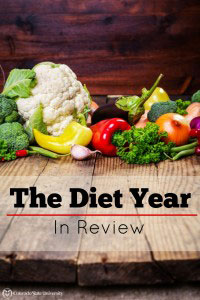As we enter a new year, many have set goals to eat better and maybe lose some newly gained holiday pounds. 2015 brought new diets and recycled old diets, and had many of us talking about what, ultimately, is the best diet.

- Top-rated diets including the DASH, TLC, and Biggest Loser diets encourage a variety of whole foods with an emphasis on vegetables, fruits, lean proteins, whole grains and healthy fats, while discouraging processed foods. With reasonable portions, this blueprint has been shown to reduce weight and chronic disease risk.
- Clean eating plans, such as The Eat-Clean Diet and The Whole 30, allow you vegetables, fruits, lean protein, whole grains and healthy fats while avoiding sugar, alcohol, additives and preservatives. Some versions eliminate grains, legumes and dairy, and others encourage you to have a cheat day. The concept encourages real foods rather than refined, which is never a bad thing, but it is not necessary to eliminate entire food groups unless you have an allergy or intolerance.
- Raw food diets claim that cooking makes food toxic, thus recommend only raw fruits, vegetables and grains. While some heating methods do destroy nutrients, there is no support for the claim that this diet pattern will cure headaches, allergies or arthritis. Even our ancestors used fire. Speaking of which…
- Paleo-type diets, including the Caveman and Stone Age diets, profess that eating like our ancestors will make us leaner and less prone to chronic disease. This diet pattern allows meat, fish, eggs, fruits, vegetables and fats while eliminating grains, beans, peanuts, dairy, sugar and processed foods. This type of diet will lead to weight loss if you typically eat excess calories, but nutrition experts discourage a high meat intake and question the need to remove whole food groups.
- Detoxes and cleanses claim to clean you out and rev up your metabolism. If you really think you need to be cleaned out (which your body does naturally), try drinking 8-10 cups of water daily and increasing your fiber intake from fruits and vegetables. Then add daily physical activity for a metabolism boost.
- Vegetarian diets range from macrobiotic to vegan to inclusion of milk and eggs but no animal flesh. Popular versions include the China Study, Engine 2 and Skinny Bitch diets, and reasons for adhering to them range from weight loss to ethical beliefs. Pro: They all encourage vegetables, fruits and whole grains. Con: Some of these diets are extremely restrictive and make outrageous claims; eating is not meant to be punitive.
- My favorite rendition is “flexitarian” eating, emphasizing a plant-based intake (vegetables, legumes, nuts, fruits, whole grains) with a side of dairy, fish, lean meats and other animal products to your liking, and minimal processed foods. This eating style steers the body to a healthy weight while reducing the risk of chronic disease.
There is no best diet for weight loss; the most successful reduces calories, period. Choose a style you enjoy and can stick with, and include regular physical activity. For non-dieting tips, see our January newsletter atwww.nutritioncenter.colostate.edu.
Happy eating and Happy New Year.
Melissa Wdowik, PhD, RDN, is an assistant professor at Colorado State University in the Department of Food Science and Human Nutrition, and director of the Kendall Anderson Nutrition Center.





